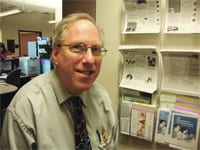Nothing to Sneeze At RSV Poses a Risk to Newborns and Premature Infants
Chances are, if you’re the parent of a newborn infant, you’re already very aware of the letters RSV.
Respiratory syncytial virus is an all-too-common threat that can lead to cold and flu-like symptoms in older individuals, from young to old. But for newborns, especially premature infants or those with compromised immune systems, the results can be much more severe.
According to doctors from the National Medical Assoc., RSV is responsible for the hospitalization of up to 125,000 infants every year. The Centers for Disease Control and Prevention estimates that RSV is responsible for the deaths of 14,000 people annually. The season for this virus hasn’t fully started yet, said Dr. Robert Kaslovsky, chief of Baystate Children’s Hospital’s Pediatric Pulmonary Division, but, “reliably by mid-December, it will.”
The risk season extends through mid-April, but just as the virus leaves this area, it circulates to the opposite hemisphere, which makes RSV cases during summer months rare, but not unheard of.
Most people are exposed to RSV by the time they are 2 to 3 years old, said Dr. Daniel Parrish, a pediatrician with Western Mass Pediatrics in Holyoke. But for the worried parents of young children, the greatest risks are for those smallest of infants. “Depending on how fragile the infant is,” he said, “it can take a baby’s life.”
Kaslovsky said that full-term newborns in the first three months of life are at risk, and for premature infants he will consider them at risk up to age 2. But he added that patients who have pre-existing lung or heart problems are also be at higher risk.
Dr. Dorothy Kelly, also of Western Mass Pediatrics, explained that this virus which attacks the pulmonary system “will start out as a cold.”
“The baby will have a runny nose and a cough,” she continued, “And you don’t identify it as anything differently at that point. But then it becomes a bad cough, and for babies who are having problems, typically they’ll have a fever, like most babies who aren’t feeling well. And then they won’t be able to feed well.”
The virus is different from the more commonly-known flu strains of this season, and those differences make noticeable results.
“Flu gives you high fevers, muscle aches, chills, and occasionally pneumonia,” Kaslovsky explained. “RSV doesn’t give you the systemic symptoms, but it affects your lungs and can give babies bronchiolitis,” a swelling of the tiny airways in the lungs. “That’s the disease that we worry about.”
And that’s where those smallest infants are most at risk. The virus kills off the airway cells and creates a lot of mucus in the airways, and as the tiny airways of the smallest infants get plugged up with mucus, “that’s where babies get into trouble,” Kasolvsky said.
“For a 4- or 5-year-old, yes, you might get RSV, but you’re not going to bronchiolitis, unless you have an immune deficiency of some kind,” he added. “The virus will just run its course.”
As a respiratory virus, Kelly noted that it’s not just parents of premature infants that should be aware. “You can have a healthy baby, but a family history with asthma,” she explained. “Or you could have an infant that’s in a smoking environment. Both of those children are going to be at risk with RSV.”
Take a Deep Breath
For those parents of children in risk groups, a major warning sign of RSV is wheezing. “Your baby might have a cold with a stuffy nose,” Kaslovsky said, “but that’s not the warning sign. It’s the bronchiolitis and wheeze, the struggle to breathe.”
As RSV is one of the ailments of the season for which doctors are on the lookout, Parrish said that sometimes it is better to err on the side of caution. “One of the things I tell newborn parents is that, if your baby gets a cold in the first few weeks of its life, it will probably have a fever, a decreased appetite,” he explained. “That’s the way babies are when they have a cold. But in those first few weeks, the baby’s immune system isn’t as capable, and germs can take over a baby very quickly.”
But, he added, “that cold presents the exact same symptoms that they would have with a dangerous infection. So we recommend that, the first few weeks of life, if your baby looks sick, a medical professional needs to evaluate that child to make sure that it’s not something dangerous.”
A nasal swab test for RSV exists, but it is very expensive. Meanwhile, there are no targeted treatments for RSV, and as a viral infection, it is not treatable with antibiotics. “There are antiviral drugs, but they tend to have a lot of side effects,” Parrish said. “Because of that, they aren’t a first-line treatment.”
For babies born at 32 weeks and under, 34 if a congenital heart disease is present, a vaccine can be administered by injection every month for the five months of RSV season. “It’s very expensive,” Kelly said, “but insurance does cover it.”
At around $1,000 a dose, this passive-immunity vaccine is not something that can be administered outside of high-risk populations, and there are strict criteria to meet in order to get it.
But given that RSV is considered a seasonal epidemic, treatment proceeds with the presumption that an infant has been exposed. “Most of the time, when a child has RSV, we don’t even diagnose it,” Kelly said. “If it’s the RSV season, it most likely is RSV.”
If a child is infected with RSV, supportive care is given, usually at home, unless the child’s hydration or respiration becomes compromised.
“If they can’t feed well because they can’t breathe at the same time,” Kaslovsky said, “they’ll get dehydrated or their oxygenation will get low. At that point, they need mist treatments, chest percussion, and suction catheters for their airways.”
But that’s the worst-case scenario. Kelly said that at least 90{06cf2b9696b159f874511d23dbc893eb1ac83014175ed30550cfff22781411e5} of RSV cases will be treated at home, taking steps to keep fever down and using nebulized Albuterol, administered via inhaler, to open up the sufferer’s respiratory tubes.
Ounces of Prevention
Pediatric nurses at Baystate Children’s Hospital recently undertook a project to further bring RSV to the attention of patients, hospital staff, and the public by helping to write and create a brochure on the highly contagious virus.
The nurses, all members of the Nursing Clinical Practice Committee in Pediatrics, selected public awareness of RSV as one of their projects for the year.
“Last year there was a lot of attention on the swine flu. We see so many sick children with RSV that we thought, if we did more public awareness on the contagious virus and address what parents can do to prevent its spread, then we might see fewer admissions to the hospital,” said Argira Manferdini, a staff nurse in the Pediatric Intensive Care Unit.
Manferdini was assisted in writing the brochure by Mary Duggan, staff nurse in the Pediatric Intensive Care Unit; Lisa Pelland, staff nurse from the Pediatric Flex Team, and Patricia Daviau, infection control practitioner at Baystate Medical Center.
“Initially we will be printing 5,000 copies of the brochure, which we plan on making available to nurses to distribute to families at the hospital,” Manferdini said. “Our hope is to also make it available to pediatricians in the community for use in their waiting rooms.”
The take-home message for RSV, Parrish said, is the same as other infections.
“We know that your toddler is going to roll around on the floor and touch the dog’s dish and put things it finds in its mouth when you’re not looking,” he said. “We expect that, and the immune system can deal with that.
“But for the first few weeks of life,” he continued, “you really need to be careful with what your child is exposed to. Being careful about exposing your newborn to crowds is incredibly important during RSV season.”
Parents can take steps to decrease the chance of their child having problems with a respiratory virus, Kelly emphasized. “And some important ways they do that is to decrease cigarette exposure to their child, and not expose their child unnecessarily to people with colds.”
That can mean large crowds in public — the shopping mall or grocery store, for instance — but can also be a far more domestic scene.
“And that’s part of the problem,” Parrish said. “Big sister will come home from kindergarten, or daddy will come home from work with a cold, they give a kiss to their baby, and that baby can end up on a respirator in an intensive care unit a week later.” Children who must attend day care during this season are also at greater risk.
In short, there’s no easy or good way to prevent exposure to RSV, Kaslovsky said.
“Washing hands, cleaning surfaces, avoiding day care — but that one is my bias,” he said. “If you can keep your child away from groups of 50 to 100 others, that’s better. But not everyone can do that, I know. I always tell parents with newborns who have school-age children in the house, when they come home, change their clothes, and if they are coughing and sneezing, obviously, stay away from the baby.”
Because sometimes it’s the smallest actions, he said, that can produce the best results, and have everyone in the family breathing a little easier.


